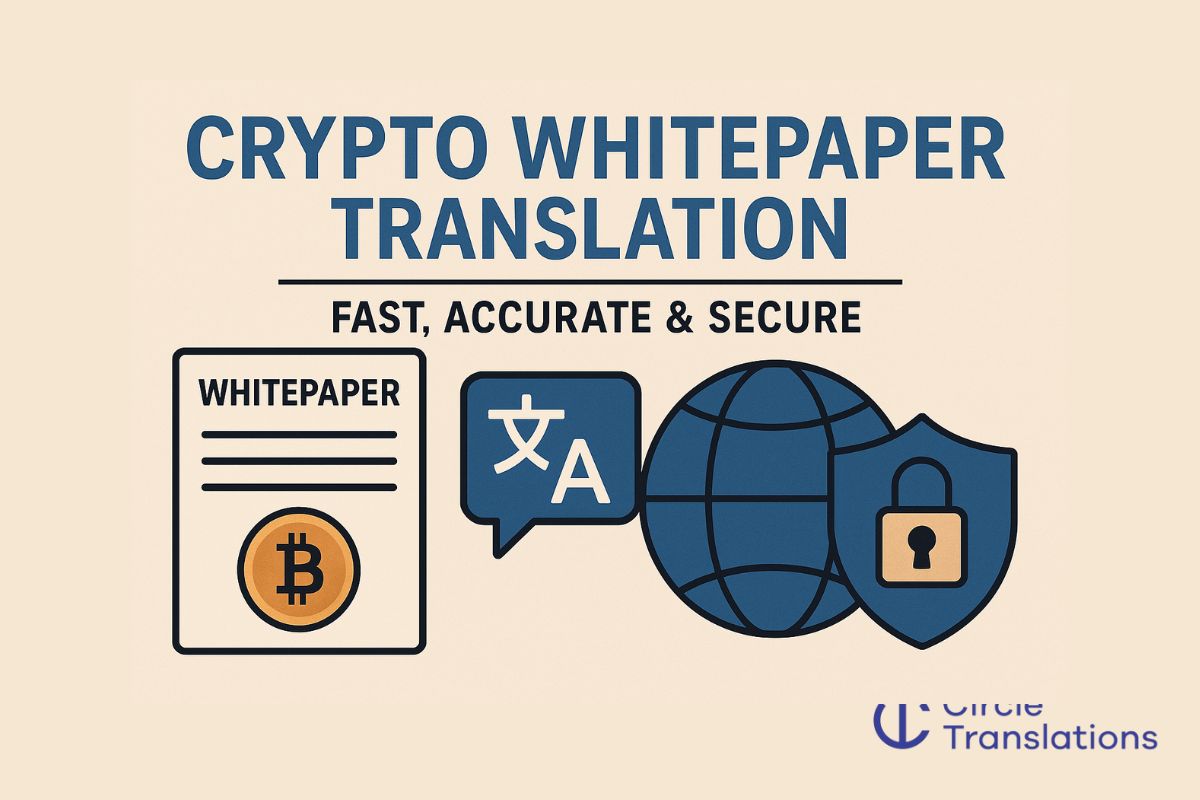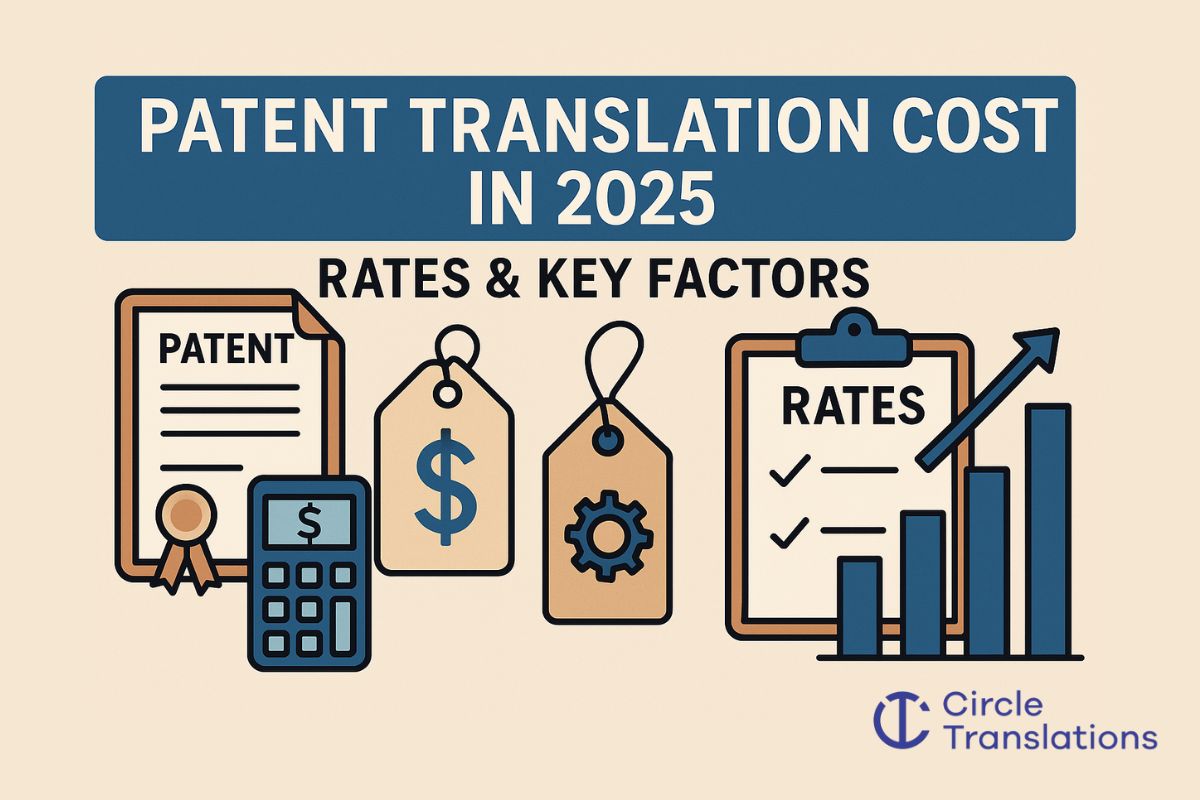In this financial era, we all know crypto is a very hype investment. Crypto whitepaper translation is now an essential success factor for Web3 teams, especially those preparing for exchange listings, community launches, and international investor outreach. Nowadays, this is important because:
- Required for many exchange listings.
- Builds global investor trust.
- Expands reach in Web3 communities.
- Ensures regulatory and legal clarity.
- Preserves accuracy in tokenomics and governance.
- Accelerates funding from global VCs.
In this whitepaper, from tokenomics breakdowns to governance models and legal disclaimers, every term matters. Also, every error can cost trust, capital, or compliance.
At Circle Translations, we specialize in crypto Whitepaper Translation, litepapers, token models, roadmaps, and investor decks, with native linguists, fast turnaround, and end-to-end data security. We offer human translation workflows for better translations.
So far, we deliver whitepaper translation in 120+ languages with certified crypto translators, fast PM response, secure infrastructure, and built-in revisions.
What is Crypto Whitepaper Translation — and Why Does Precision Matter?
Crypto whitepaper translation refers to the process of translating blockchain project documentation, like whitepapers, litepapers, tokenomics models, governance outlines, and roadmaps, from one language to another. During that translation time, it has to preserve technical accuracy, legal clarity, and strategic messaging.
This is not like other standard document translations. This process requires specialized linguistic and domain expertise in Web3, DeFi, Layer 2 protocols, token engineering, and blockchain consensus mechanisms.
A crypto whitepaper is not just about technical terms. It is your project’s first impression to global investors, exchanges, auditors, and communities. It talks about your:
- Protocol architecture
- Consensus model, like Proof of Stake, Proof of Authority
- Tokenomics (supply, emissions, vesting, burns, lockups)
- Governance structure (DAO voting, multi-sig control)
- Market vision and roadmap
A single mistranslation in any of these areas can jeopardize investor trust, violate exchange listing standards, or misstate legal obligations across jurisdictions.
Why General Translators Often Fail in Web3
Translators without blockchain fluency can misinterpret key concepts, especially when faced with:
- Evolving crypto jargon not found in traditional glossaries
- Protocol-specific terminology unique to your project, for example: zk-rollup verifier, slashing, liquidity mining
- Legal disclaimers with jurisdictional nuance, like securities classification, KYC/AML compliance
- Mathematical or code-annotated content such as token curves, hashing functions, or staking algorithms
Here I am giving some common examples that might happen in your whitepaper during translation:
- “Burn” can be mistaken for destroying tokens instead of reducing supply.
- “Staking rewards” may be seen as a salary instead of investment returns.
- “Liquidity lock” could be misread as freezing an account, creating false risk concerns.
These are minor errors, but they can lead to investor confusion, legal misalignment, or delays in listing approval.
Why Precision Is Critical in Crypto Translation
A crypto whitepaper must achieve three things across all translated versions:
- Accuracy — technical descriptions must match the original intent without dilution or over-simplification.
- Clarity — information should be readable by both crypto-native audiences and institutional readers.
- Consistency — terminology must be harmonized across translations to prevent semantic drift.
This is especially crucial in sections involving:
- Token issuance & utility
- Consensus logic
- Vesting & lockup mechanisms
- Treasury and fund allocation
- Jurisdictional legal disclaimers
Each Misrepresented word carries regulatory, reputational, or financial risk. So, here I give a standard workflow for this:
- Domain-specific glossaries
- LQA frameworks (like MQM or DQF)
- Human linguists with Web3 experience
- Optional review by legal or technical SMEs
Industry Insight: What Competitors Emphasize
Many agencies, translations, and financial Translation Services highlight that accurate whitepaper translation directly impacts funding, token launches, and regulatory approval. Most failures stem from misinterpreting blockchain terms or overlooking technical details.
At Circle Translations, we close this gap by using native crypto linguists with DeFi, legal, and financial expertise. Each whitepaper goes through dedicated project management and a strict QA Process.
Where Do Mistranslations Cause Risk?
Mistranslations in crypto whitepapers are most risky in tokenomics, consensus models, governance, legal disclaimers, and risk factors. These parts affect money and compliance, so even minor errors can mislead investors or create legal issues. For safety, use human translators with crypto expertise.
Here’s where precision matters most:
1. Tokenomics
Includes emission models, inflation rates, burn mechanics, vesting, token supply limits, and reward logic.
- Why it’s risky: Misrepresenting supply caps or emission schedules can undermine investor trust and distort financial models.
2. Consensus Mechanisms
This explains your protocol’s method of reaching agreement, such as PoW, PoS, DPoS, zk-rollup.
- Why it’s risky: Mistakes in validator roles, staking requirements, or slashing conditions can confuse developers and governance participants.
3. Governance Framework
This framework outlines DAO logic, voting mechanisms, proposal thresholds, and community control.
- Why it’s risky: Errors here can lead to misinterpretation of who controls the protocol or how decisions are made, which affects token valuation and decentralization claims.
4. Legal Disclaimers
This is one of the critical parts of the documents as it illustrates jurisdiction-specific language about investment risk, forward-looking statements, or KYC/AML obligations.
- Why it’s risky: Inaccurate disclaimers may result in legal exposure or non-compliance in regions like the U.S., EU, or Asia.
5. Risk Factors
In this section, highlights operational, technical, and legal vulnerabilities of the protocol.
- Why it’s risky: A misinterpreted risk disclosure can downplay real threats that will lead to investor misinformation or regulatory scrutiny.
From my perspective, these sections should translate human-only translation, dual QA, and blockchain-literate linguists. If anything less happens here, it can create significant financial and legal risks.
How We Keep Translations Both Fast and Accurate
At Circle Translations, we put your needs first. Our workflow adapts to your priorities, whether speed, quality, or both.
Human-Only Workflow (for high-importance docs):
Used for:
- Tokenomics
- Legal disclaimers
- Regulatory documents
- Exchange submission packs
This model approach helps our clients to get high-quality documents and avoid risks.
Security First: How We Protect Investor Decks & Repositories
We mirror the security practices of leading financial translation providers. Our infrastructure includes:
- End-to-end encryption of all files, both at rest and in transit, to safeguard sensitive crypto and blockchain data.
- NDA coverage is signed before any project begins, ensuring confidentiality from day one.
- Secure client portal for encrypted file transfer, project tracking, and centralized communication.
- Role-based access control (least-privilege model) so only authorized linguists and engineers can access specific files.
- Audit trails for every action taken during translation, review, and file engineering.
- GDPR compliance with transparent data processing practices for global trust.
- Pre-vetted linguists with crypto and fintech expertise, each cleared under strict confidentiality agreements, ensuring domain accuracy and information security.
Which Languages Matter for Web3 Go-to-Market?
The most important languages for Web3 whitepaper translation are Simplified Chinese, Japanese, Korean, German, and Spanish. These markets offer high user adoption, liquidity, and exchange reach. Translating into these languages improves listing opportunities, investor clarity, and regulatory compliance.
Launching a crypto project globally requires more than just code. It needs clear, compliant communication in the languages of your target markets. Whitepaper translation plays a critical role in attracting early investors, securing exchange listings, and building community trust.
Here I explain some of the top languages for crypto whitepaper translation, based on user volume, trading activity, regulatory interest, and regional exchange access:
Simplified Chinese (ZH)
Why it matters:
Mainland China and greater Chinese-speaking regions (including Taiwan, Hong Kong, and Singapore) continue to be home to a massive base of crypto users, developers, and investors, despite restrictions.
Use case:
Many centralized and decentralized exchanges prioritize Simplified Chinese whitepapers for review and listing. Community trust is heavily influenced by localized documentation.
Japanese (JA
Why it matters:
Japan has a highly engaged retail investor base. A growing number of licensed crypto exchanges, and strong regulatory oversight under the Financial Services Agency (FSA).
Use case:
Translation into Japanese is a must for token listings on local exchanges like bitFlyer or Coincheck. It is also needed for gaining traction with local developer communities, especially in DeFi and NFTs.
Korean (KO)
Why it matters: South Korea has some of the highest crypto penetration rates in the world. Korean traders are active in DeFi, altcoin speculation, and exchange-based liquidity.
Use case:
Many Korean exchanges require native-language whitepapers as part of their due diligence process. Korean-language Telegram groups and community hubs also drive early momentum.
German (DE)
Why it matters: Germany leads in crypto regulation within the EU and has a strong foundation of institutional investors, legal firms, and blockchain startups.
Use case:
Translating into German is critical for whitepapers that will be used in EU regulatory filings, pitch decks to VC firms, or applications for EU funding programs (like the EIC).
Spanish (ES)
Why it matters: Spanish is the second-most spoken language by native speakers globally, with strong crypto growth in Latin America, including Mexico, Argentina, Colombia, and Venezuela.
Use case:
Translating into Spanish helps reach underbanked populations engaging with crypto as an alternative to unstable fiat systems.
Why Language Selection Matters
Choosing the right languages isn’t just about reach; it’s about reducing friction at every phase of your go-to-market strategy:
- Exchange Listings: Many exchanges require local-language whitepapers for review
- Investor Relations: Regional VCs and angel investors often demand content in their native language
- Regulatory Compliance: Localization ensures legal disclosures meet local jurisdictional norms
- Community Growth: Whitepapers help bootstrap early community trust when properly localized
Methodology & Deliverables for Crypto Whitepaper Translation
Usually, Crypto whitepaper translation deliverables include a final localized PDF, the editable source file (such as Word, InDesign, or Markdown), a bilingual review sheet, a terminology glossary, and a change log. Optional add-ons may cover diagram localization, math or code QA, and desktop publishing (DTP) to ensure layout integrity.
At Circle Translations, we approach crypto whitepaper translation with a workflow designed for speed, accuracy, and audit-readiness.
Methodology Overview
Our workflow reflects a balance of automation and expert human review, tailored to the unique challenges of DeFi, Layer 2, exchange listings, and DAO-based governance documents:
- Pre-processing (Optional AI Pre-draft)
- For speed-critical use cases, we offer domain-tuned machine translation (MT) to prefill drafts.
- These drafts are never delivered raw; expert post-editing by crypto linguists follows them.
- Human Translation by Native Crypto SMEs
- Core content (tokenomics, governance, consensus) is always handled by human translators fluent in blockchain concepts and terminology.
- Terminology consistency is ensured using client-approved glossaries and our centralized Translation Memory (TM) system.
- Linguistic QA & Revision
- A second linguist performs a full-scope review (LQA) using ISO 17100-compliant frameworks (MQM/DQF).
- Optional input from legal or technical SMEs for token definitions, formulas, or math-based protocol logic.
- PM Review & Final QA
- Our dedicated project manager validates the full deliverable, including layout integrity and terminology alignment.
- The final file goes through a QA checklist: completeness, formatting, client style guide compliance, and glossary coverage.
Format & File Support
We support crypto-native documentation across:
- Markdown (.md)
- Google Docs
- InDesign (.indd)
- Illustrator (.ai)
- LaTeX (.tex)
- CSV/JSON for glossary and UI content
We also maintain structure in code-heavy content, ensuring:
- No changes to function names or code syntax
- Developer comments, user-facing messages, and inline documentation are correctly localized
- Markdown tables, footnotes, and anchor links remain intact
Final Output: Ready for Community, Investors & Exchanges
The complete package we deliver is designed for:
- Investor decks
- Exchange listing submissions
- DAO proposal documentation
- Press/media kits
- Pitch decks & community roadmaps
Circle Translations ensures that every deliverable reflects the quality, security, and professionalism that Web3 founders, legal teams, and investor relations teams demand.
Who Works on Your Whitepaper? (Roles & Vetting)
A crypto whitepaper translation team generally includes a native crypto linguist, reviser, LQA lead, and dedicated project manager. Each is checked for blockchain domain knowledge, translation accuracy, and confidentiality. Circle Translations adds ISO-aligned QA, conflict checks, and reviewer handoffs for security and precision.
1. Crypto Linguist (Lead Translator)
What they do:
Their main task is to translate the whitepaper from the source to the target language while preserving blockchain terminology, technical meaning, and legal phrasing.
What we require:
- Translations delivered by native speakers in the target language.
- Coverage of 120+ languages worldwide.
- Team includes professional linguists with subject-matter expertise.
- Emphasis on accuracy, consistency, and cultural relevance.
- Quality assurance aligned with ISO standards.
- Secure workflows including NDA protection and GDPR compliance.
- Flexible service tiers (Basic, Business, Pro, Custom) with revisions included.
- Support for multiple file types and DTP/engineering needs.
Why it matters:
Translating token emissions or governance mechanics requires contextual understanding, not just language fluency.
2. Reviser / Second Linguist
What they do:
Performs a full pass on the initial translation, comparing it to the source to verify accuracy, tone, and terminology consistency.
What we require:
- Translations go through a second linguist (reviser) for proofreading and editing.
- QA follows a two-step process: translator → reviser.
- Reviser ensures grammar, terminology, and style consistency.
- Corrections are tracked in a change log or bilingual review file.
- Aligns with ISO 17100 requirements, where revision by a second qualified linguist is standard.
Why it matters:
Revisions catch blind spots, especially in legal disclaimers, math-heavy sections, or function labels.
3. LQA Lead (Linguistic Quality Assurance)
What they do:
Oversees compliance with ISO 17100 or custom QA protocols. They check for adherence to glossaries, checklists, and client-specific instructions.
What we require:
- Advanced training in LQA standards (MQM, DQF)
- At least one prior whitepaper audit or crypto/financial documentation review
- Comfort with CAT tools and QA software
Why it matters:
LQA leads ensure translation is of high quality. It’s verifiably good, even for investor scrutiny or legal filings.
4. Dedicated Project Manager (PM)
What they do:
Manages the full lifecycle of your project, from kickoff to delivery. They are also coordinating linguists, file engineers, and reviewers.
What we provide:
- Availability across time zones
- NDA, file security, and document workflow control
- Client communication, change requests, and version tracking
- Optional direct coordination with legal/IR teams
Why it matters:
Your PM is your single point of contact. He is actually someone who knows your terminology, timelines, and what’s at stake.
What Files and Formats Do We Support?
At Circle Translations, we understand that crypto whitepapers don’t just live in PDFs. They’re shared across GitHub repos, token launchpads, investor decks, governance forums, and centralized exchange listing portals. Each demands a different format, layout, or integration.
That’s why our translation infrastructure is built to support the most common file types used in the Web3 ecosystem, including both technical documentation and investor-facing materials.
We ensure all formatting, code structures, and visual components are preserved, while translating only what needs to be localized.
Format-Aware Translation Practices
I am showing you all how to get some ideas about this document’s format.
- Code Block Protection:
In Markdown or LaTeX files, we lock inline code and executable functions. Only human-readable comments or explanatory strings are translated. - String Label Handling:
For JSON/CSV files, we localize user-facing strings while preserving keys and metadata. For example, “wallet_error_message”: “Invalid passphrase” becomes localized, while the key stays intact. - Visual QA for Diagrams & Charts:
For InDesign, Illustrator, or embedded graphics, we offer optional visual QA. Diagram labels, axis captions, and legend text are translated — without altering the original layout unless requested. - Math & Formula Integrity:
In LaTeX or PDF diagrams, mathematical expressions remain untouched unless specified. We only localize variable definitions or written explanations around the formulas.
Figure & Caption Localization
Most of the time, Whitepapers include infographics, timelines, and architecture diagrams. We provide localization support for:
- Caption text and image annotations
- Diagrams with embedded callouts
- Workflow visuals with multilingual versions
- Screenshot-based UI flows with region-specific overlays
Final Output: Ready to Publish, Print, or Submit
Once the translation is complete and reviewed, we return:
- Fully translated, layout-ready PDFs
- Clean, editable source files in your original format
- Multilingual versions of all diagrams (if requested)
- Translation memory exports (optional)
- Glossary files in JSON, CSV, or Excel format
Use Cases: ICOs, Listings, L2 Launches, DeFi Updates
Here are some of the use cases:
- ICO/IEO Launches – Whitepaper + pitch deck + tokenomics summary
- Exchange Listing Packs – Whitepaper, one-pager, ToS, risk disclosures
- Layer-2 or Bridge Launches – Technical roadmap + validator onboarding
- DeFi Feature Updates – Governance update, proposal translation, staking logic
- Cross-chain Integration – Developer docs, litepaper, and integration terms
Why Us for Crypto Whitepaper Translation? (B2B Benefits)
For crypto projects going global, precision, speed, and confidentiality are essential. At Circle Translations, we provide whitepaper translation tailored for B2B clients in Web3, DeFi, Layer-2, and blockchain VC networks.
From exchange listings and investor decks to DAO governance docs, we deliver fast, accurate translations that meet blockchain-native expectations.
That’s why technical teams, investor relations, and compliance leads across the crypto space trust Circle Translations.
Speed: Onboarding to Delivery
- Project management with global team coverage
- Same-day onboarding with rapid linguist matching
- Rush options available for urgent exchange or investor deadlines
- Scalable resources to handle high-volume or multi-language projects
.
Accuracy: Crypto-Native Linguists, Not Generic Translators
- All translators are native speakers with proven blockchain fluency.
- We maintain a custom glossary per project to ensure consistent use of DeFi terms, consensus models, and token mechanics
- Every translation passes dual-layer QA, including linguistic review and style conformity
- Terminology management is aligned with your whitepaper, brand, and protocol documentation
Security: Enterprise-Grade Confidentiality
- NDA-based workflows from pre-kickoff through delivery
- End-to-end encryption across file storage and communication
- Role-based access control, with “least-privilege” permissions for linguists
- Full audit trails for file access, edits, and approvals
- GDPR-compliant infrastructure, with optional security add-ons upon request
Coverage: 120+ Languages, Multiformat Capability
- Native teams for Chinese (ZH), Japanese (JA), Korean (KO), German (DE), Spanish (ES), and beyond
- Format support includes Markdown, InDesign, LaTeX, Google Docs, PDF, Word, JSON, and CSV
- Desktop Publishing (DTP) is included for visually rich documents.
- UI strings, charts, diagrams, and code-adjacent content are handled with care
Transparency: Full Visibility Into the Process
- Tracked changes and revision logs on every version
- Shared bilingual review files for your internal team to verify
- Centralized termbase access for client-side reviewers
- Final delivery reports with status, timestamps, and file history
Customized Service Available for Every Stage
Choose the QA and service level that matches your timeline, content criticality, and budget:
- Basic — fast delivery with a single-linguist pass for non-sensitive content
- Business — standard LQA and term control for most whitepapers
- Pro — complete multi-linguist QA + diagram localization + DTP
- Custom — security-first, multi-market launch support, legal consultation, and more
RFP Checklist for Crypto Whitepaper Translation Vendors
Use this checklist when selecting a translation partner for your Web3 project:
- Certified linguists under ISO 17100
- NDA compliance with secure portal access
- Defined glossary and terminology management
- Access to subject-matter experts in crypto/DeFi
- Linguistic QA framework (MQM or DQF) in place
- Ability to manage code snippets and figures
- Strict SLA compliance with on-time delivery tracking
- Full TM ownership and glossary consistency
- QA samples and client references available in your sector
Ready to Translate Your Whitepaper?
Expanding into new markets starts with clarity, and your whitepaper is the first impression for investors, exchanges, and communities worldwide. At Circle Translations, we specialize in fast, secure, and accurate crypto whitepaper translation for DeFi protocols, Layer-2 networks, DAOs, and blockchain startups.
With native crypto linguists, ISO-aligned QA, and end-to-end confidentiality, we help ensure your protocol is understood exactly as intended, almost in every language.
Frequently Asked Questions
What makes crypto whitepaper translation different from general translation?
Crypto whitepaper translation combines financial, technical, and blockchain-specific terminology, such as tokenomics, consensus mechanisms, and staking logic. It is not like general content. Mistranslations here can create regulatory issues or mislead investors about protocol functionality.
Can AI help speed up whitepaper translation without sacrificing quality?
Yes. When used strategically. We leverage domain-trained machine translation for initial drafts, but apply human post-editing, LQA, and SME review to ensure accuracy. Sensitive sections (like tokenomics or legal disclaimers) are always translated by humans only.
Do you translate code in whitepapers?
Yes, but only comments, strings, and documentation, not executable code. Protocol names, function identifiers, and code logic are preserved unless you request otherwise. We follow your glossary and coding standards to protect technical integrity.
Which languages should we prioritize for a token launch?
Start with Simplified Chinese, Japanese, Korean, German, and Spanish. These cover key retail and institutional crypto markets, align with major exchange requirements, and support localized community engagement in Asia, LATAM, and DACH regions.
What deliverables do we receive?
You’ll receive:
- Final translated PDF
- Editable source files (e.g., InDesign, Markdown, LaTeX, DOCX)
- Bilingual review file
- Centralized terminology sheet
- Change/revision log
- Optional DTP or diagram localization
All assets are publication-ready and format-matched to your original content.











